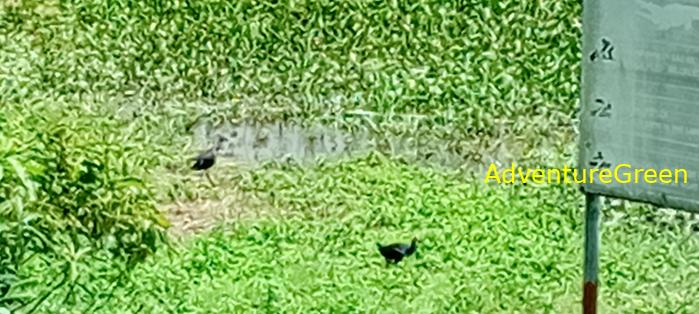Birds of Vietnam, Bird Species in Vietnam

Let's join AdventureGreen on our bird quests to learn about the different birds and bird species in Vietnam. Here you can find out more about the birding spots that these bird species are found.
- Order: Pelecaniformes
- Family: Ardeidae
- Genus: Ardeola
Chinese pond heron
(Cò bợ, Ardeola bacchus)
The Chinese pond heron (Ardeola bacchus) is an East Asian freshwater bird of the heron family, (Ardeidae).
The scientific name Ardeola comes from Latin ardeola, a small heron (ardea).
bacchus Latin bacchus wine
(wine-coloured, Mythology: Bacchus, son of Jupiter and god of wine).
- Order: Pelecaniformes
- Family: Ardeidae
- Genus: Ardeola
Javan pond heron
(Cò bợ Java, Ardeola speciosa)
The Javan pond heron (Ardeola speciosa) is a wading bird of the heron family, found in shallow fresh and salt-water wetlands in Southeast Asia.
The scientific name Ardeola comes from Latin ardeola, a small heron (ardea).
speciosa, speciosum, speciosus Latin speciosus splendid, beautiful (species beauty).
- Order: Pelecaniformes
- Family: Ardeidae
- Genus: Egretta
Little egret
(Cò trắng, Egretta garzetta)
The little egret (Egretta garzetta) is a species of small heron in the family Ardeidae.
- Order: Pelecaniformes
- Family: Ardeidae
- Genus: Egretta
Pacific reef heron
(Cò đen, Egretta sacra), also known as the eastern reef heron or eastern reef egret
The Pacific reef heron (Egretta sacra), also known as the eastern reef heron or eastern reef egret, is a species of heron found throughout southern Asia and Oceania.
Ardeidae, Ardea: the Latin word ardea meaning "heron".
The genus name comes from the Provençal French for the little egret, aigrette, a diminutive of aigron, "heron".
In Latin, "sacra" is a plural noun referring to "sacred things" or religious rites.
- Order: Passeriformes
- Family: Ploceidae
- Genus: Ploceus
(Rồng rộc, Ploceus philippinus)
The baya weaver (Ploceus philippinus) is a weaverbird found across the Indian Subcontinent and Southeast Asia.
The genus name is from Ancient Greek plokeus meaning "weaver" derived from the Greek word pleko "to entwine".
- Order: Passeriformes
- Family: Ploceidae
- Genus: Ploceus
Streaked weaver
(Rồng rộc đen, Ploceus manyar)
The streaked weaver (Ploceus manyar) is a species of weaver bird found in South Asia and South-east Asia in the countries of Bangladesh, Bhutan, Cambodia, China, Egypt, India, Indonesia, Myanmar, Nepal, Pakistan, Singapore, Sri Lanka, Thailand, Vietnam and also introduced in Qatar and United Arab Emirates (UAE).
The genus name Ploceus is from Ancient Greek plokeus meaning "weaver" derived from the Greek word pleko "to entwine".
manyar: Tamil name Manja for various weavers (Ploceus).
- Order: Gruiformes
- Family: Rallidae
- Genus: Rallina
Red-legged crake
(Gà nước họng nâu, Rallina fasciata)
The red-legged crake (Rallina fasciata) is a waterbird in the rail and crake family, Rallidae.
The bird is found in far north-eastern India, eastern Bangladesh, Myanmar, Thailand, Malay Peninsula, Borneo and Indonesia.
The genus name Rallina is feminine diminutive of Medieval Latin rallus (“rail”).
New Latin fasciatus means banded or striped.
- Order: Gruiformes
- Family: Rallidae
- Genus: Rallina
Slaty-legged crake
or banded crake
The slaty-legged crake or banded crake (Rallina eurizonoides) is a waterbird in the rail and crake family, Rallidae.
The bird is found in India, Pakistan, and Sri Lanka to the Philippines, Indonesia and Vietnam.
The genus name Rallina is feminine diminutive of Medieval Latin rallus (“rail”).
(Gà nước họng trắng, Rallina eurizonoides)
eurizon in Greek means Euro. "-oides", "oida" is Greek or Latin for like, resembling, descendant of.
- Order: Passeriformes
- Family: Timaliidae
- Genus: Mixornis
Pin-striped tit-babbler
(Chích chạch má vàng, Mixornis gularis), also known as the yellow-breasted babbler
The pin-striped tit-babbler (Mixornis gularis), also known as the yellow-breasted babbler, is a species of bird in the Old World babbler family Timaliidae that is found in South and Southeast Asia.
Timaliidae, Timalia: The word "Timalo" originates in the Greek "Thimalos", which means "bird". This Greek root was adapted to Latin as "Timalus" and later to Portuguese as "Timalo".
The genus name Mixornis combines the Ancient Greek mixis meaning "mixed" or "mingling" with ornis meaning "bird".
The specific epithet gularis is Modern Latin meaning "-throated".
- Order: Passeriformes
- Family: Cisticolidae
- Genus: Orthotomus
Dark-Necked Tailorbird
Black-necked Tailorbird (Chích bông cánh vàng, Orthotomus atrogularis)
The dark-necked tailorbird (Orthotomus atrogularis) is a songbird species of the family Cisticolidae.
The bird is found in Bangladesh, Northeast India and Southeast Asia.
The name Cisticoladae from Cisticola, which is from Ancient Greek kisthos, "rock-rose", and Latin colere, "to dwell". ... cisticola).
Orthotomus: from the Ancient Greek orthotomeō, meaning 'to cut straight'.
atrogularis Latin ater: black; Latin: gularis -throated (Latin gula throat).
- Order: Passeriformes
- Family: Cisticolidae
- Genus: Orthotomus
Ashy Tailorbird
(Chích bông xám tro, Orthotomus ruficeps)
The ashy tailorbird (Orthotomus ruficeps) is a species of bird formerly placed in the "Old World warbler" assemblage, it but now placed in the family Cisticolidae.
The bird is found in Brunei, Indonesia, Malaysia, Myanmar, the Philippines, Singapore, and Thailand, Vietnam.
The name Cisticoladae from Cisticola, which is from Ancient Greek kisthos, "rock-rose", and Latin colere, "to dwell". ... cisticola).
Orthotomus: from the Ancient Greek orthotomeō, meaning 'to cut straight'.
ruficeps Latin rufus red, ruddy; -ceps -headed.
- Order: Passeriformes
- Family: Chloropseidae
- Genus: Chloropsis
Blue-winged leafbird (Chloropsis moluccensis)
Chim xanh Nam Bộ
The blue-winged leafbird (Chloropsis moluccensis) is a species of leafbird found in forest and second growth throughout Southeast Asia as far east as Borneo and as far south as southern Sumatra.
Chloropseidae Chloropsis In Greek mythology, the name Chloris (/ˈklɔːrɪs/; Greek Χλωρίς Chlōrís, from χλωρός chlōrós, meaning "greenish-yellow", "pale green", "pale", "pallid", or "fresh").
molucca, moluccanus, moluccensis: Moluccas, an archipelago in the eastern part of Indonesia.





































